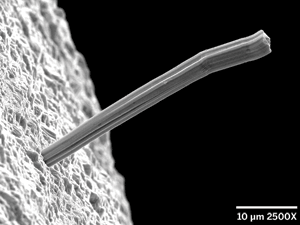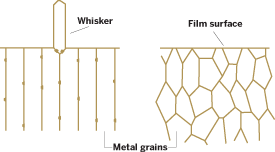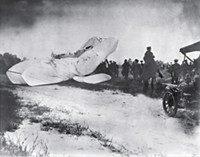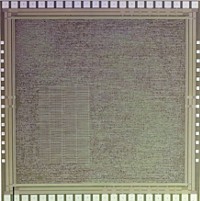Advertisement
Grab your lab coat. Let's get started
Welcome!
Welcome!
Create an account below to get 6 C&EN articles per month, receive newsletters and more - all free.
It seems this is your first time logging in online. Please enter the following information to continue.
As an ACS member you automatically get access to this site. All we need is few more details to create your reading experience.
Not you? Sign in with a different account.
Not you? Sign in with a different account.
ERROR 1
ERROR 1
ERROR 2
ERROR 2
ERROR 2
ERROR 2
ERROR 2
Password and Confirm password must match.
If you have an ACS member number, please enter it here so we can link this account to your membership. (optional)
ERROR 2
ACS values your privacy. By submitting your information, you are gaining access to C&EN and subscribing to our weekly newsletter. We use the information you provide to make your reading experience better, and we will never sell your data to third party members.
Environment
Stopping the Tin Whisker Stalkers
Researchers aim to suppress filaments that sprout from tin coatings in lead-free electronic equipment
by Sophie L. Rovner
July 16, 2007
| A version of this story appeared in
Volume 85, Issue 29

JUST AS A TINY blood clot can fell a seemingly hale human, a tin "whisker" can bring an electronic device to its knees. Electrical shorts caused by growth of these needlelike metal crystals have knocked out guided missiles and communication satellites, shut down a nuclear power plant, and caused heart pacemakers to fail.
Experts fear that many technological failures for which causes haven't been found are due to undetected tin whiskers. And even if engineers trace a failure to whiskers, that finding is rarely publicized. For both competitive and liability reasons, observers note, companies aren't eager to reveal that a flaw is lurking in their products. Instead, companies try to remedy the flaw with a minimum of fanfare and then quietly get on with business.
"The implications are enormous," says George T. Galyon, a senior technical staff member at IBM in Poughkeepsie, N.Y. Tin whiskers can put a company out of business as a result of lawsuits. They can cost a firm millions of dollars to replace components in products that have been sold but are still under warranty, he adds. Experts place the dollar costs in the billions. "Worse than that, in military applications, the implications go beyond dollars to lives," says Galyon.
Tin whiskers, which are electrically conductive, are most likely to cause a short in devices in which the electronic circuits are less than 1 mm apart, according to Galyon, who oversees IBM's tin whisker abatement efforts. The risk is even greater in an environment such as a space capsule, under the hood of an automobile, or an airplane that is exposed to severe thermal cycling and high humidity, he says. Whiskers can also grow in consumer products such as cell phones and watches, though the ramifications are far less significant.
Whiskers have been studied for more than 60 years, but environmental regulations instituted in the European Union a year ago, and under development in China, are lending added urgency to the work. That's because these regulations severely restrict the use of lead, which electronics manufacturers have relied on for decades to reduce the growth of tin whiskers.
Traditionally, lead has had three main uses in electronic hardware. First, tin-lead solder has fastened microchips and other electronic components to printed circuit boards. Second, tin-lead coatings have covered the terminals or "leads" of the components, which are often made of copper or an iron-nickel alloy. Third, such coatings have been used to cover the "pads" on the boards to which the wire leads are soldered. The pads are generally made of copper.
The tin-lead coating or plating prevents corrosion of the leads and pads and ensures that the solder makes a good connection between the two. Lead also makes solder connections more ductile and resistant to breakage when products are dropped or otherwise shocked.

THESE ADVANTAGES have made tin-lead "the finish and solder alloy of choice for the past 50 years," Galyon says. As a result of the new environmental regulations, however, tin-lead alloys for plating applications have now largely been replaced with pure tin. And tin-silver-copper solder is supplanting tin-lead solder. These switches leave electronic devices vulnerable to the growth of whiskers.
While pure tin has gained the most notoriety for developing whiskers, these pesky crystalline filaments can also grow from other metals, including cadmium, silver, and zinc. Indeed, horror stories about zinc abound. Zinc is often used to coat metal components beneath raised floor tiles in computer rooms. The zinc, which prevents corrosion, can shed whiskers into the room air if the tiles are disturbed. And when that metal-laced air is drawn into computers, it can cause large numbers of them to fail.
No matter the metal, whiskering behavior can be mystifying. Even seemingly identical plated objects can behave differently. "Some metal films come out of the plating bath and grow a whisker immediately," Galyon says. Other films don't sprout whiskers until 20 years after the plating process, and others never grow whiskers. "What is the difference?" he asks. "That is really an unknown."
While it's not possible to predict when whiskers will grow, researchers are fairly certain why they grow. In tin films, Galyon says, most experts agree that whiskers form to relieve stress.
Stress is initially created during the film-deposition process. It can be exacerbated by bending, surface corrosion, and repeated temperature cycling, particularly if there's a mismatch in the coefficient of expansion between tin and the underlying metal, notes Joseph Smetana, a principal engineer for advanced technology at Alcatel-Lucent, which makes communications equipment. Smetana heads a team that recently released recommendations to reduce the risk of failure caused by whiskering. The team was organized by the International Electronics Manufacturing Initiative (iNEMI), an industry-led consortium that has taken a lead role in addressing whiskers. Galyon, too, has been heavily involved in iNEMI's whisker projects.
After the initial plating process, film stress is affected by interactions between the coating and the underlying metal substrate. In the case of a tin film on a copper substrate, copper atoms diffuse into the tin. The copper atoms also react with tin atoms to form intermetallic compounds such as Cu6Sn5, Galyon says. Both actions distort the tin coating and build up compressive stress within the tin, which encourages whisker formation.
Other factors that favor whisker growth include scratches or nicks that damage the surface of the tin coating, according to Carol A. Handwerker, a materials engineering professor at Purdue University. Before moving to Purdue, Handwerker spent more than 20 years studying metallurgy and tin whiskers at the National Institute of Standards & Technology. NIST's whisker team continues to study causes, predictive methods, and mitigation techniques for whiskers.
WHISKERS GROW out of so-called whisker grains that form in metal films via a process that some refer to as grain growth and others describe as "recrystallization," Galyon explains. Metals consist of a collection of individual grains or crystals separated by grain boundaries. Metal films typically have vertical grain boundaries that are perpendicular to the film surface, giving the film a columnar grain structure, Galyon says. But the grain from which a whisker emerges looks like an upside-down isosceles triangle with the apex buried in the tin film and the base of the triangle at the surface of the film.
Henning W. Leidecker Jr., chief engineer in the parts branch at the National Aeronautics & Space Administration's Goddard Space Flight Center, believes that tin atoms diffuse through the grain boundaries and move to the base of the whisker. When enough atoms gather, the whisker is forced outward by one atomic layer, he says. For a whisker to grow 1 mm/year, an atomic layer must be added every 10 to 20 seconds.
"Only about one grain in 10,000 to one in 100,000 grows into a whisker," Leidecker notes. The resulting tin whiskers are so fine-typically just a few micrometers in width and usually less than 2 mm in length-that they're hard to see, even with a microscope. But these tiny filaments can have a mighty impact, as evidenced by the number of incidents listed on NASA Goddard's extensive whisker website (nepp.nasa.gov/whisker).
These incidents include a 2005 shutdown of a nuclear power plant in Waterford, Conn., that was traced to a false alarm caused by a tin whisker. In a report on the incident, Westinghouse Electric noted that "tin whiskers, resulting in minimal plant impacts, have been observed and reported in several other instances in the nuclear industry." The company recommended that utilities conduct periodic inspections for tin whiskers.
As the risks become better understood, those who use electronics are taking a more proactive approach to the whisker problem. One of Leidecker's roles at NASA is to "attempt to keep pure tin or zinc or cadmium from being used either as part of the electronics or near the electronics in our spacecraft," he says.
He has to be diligent. Although European environmental regulations allow sectors such as the military and aerospace to use leaded electronics, most suppliers don't want to bother making specialty products for these relatively small markets. As a result, Leidecker says, "it's becoming increasingly difficult to order electronic parts that don't have pure tin."
Even when parts suppliers assert they've used lead, their claims aren't always reliable, he adds. Often, 1.5-2.5% of parts come through with pure tin, though that error rate sometimes spikes. In a recent batch of parts, that figure jumped to 70%. "So we check what we get to establish the actual lead content," Leidecker says.
Sometimes, whiskers crop up on parts that were manufactured before NASA realized that pure tin on nonelectronic parts could be problematic. About 18 months ago, one of the electronics boxes for the space shuttle Endeavour developed a fault. When NASA technicians opened that box and others intended for the shuttle, they discovered that tin-coated circuit-board clamps inside each box were forested with at least a million whiskers, some as long as 20 mm.
"The dense growth of long tin whiskers on the clamps is a very conspicuous problem, and it has been pesky and expensive to fix," Leidecker says. The clamps have been replaced with others that can't grow whiskers. The circuit boards have been laboriously cleaned. And technicians have touched up some gaps in the boards' insulating coating so that stray whiskers that fall onto the boards are less likely to cause a short. But Leidecker notes that some circuit board areas—such as the mating parts where the boards plug into sockets at the back of each box—can't be coated. As a result, "some potential shorting sites remain."
Boards can be cleaned with compressed air, brushing, or vacuuming. However, those techniques can detach the whiskers, which then can travel around the board's surface and cause problems if they're not captured. "We have seen failure rates of cleaned equipment go up by a factor of five or more as the dislodged whiskers find their way into dangerous locations," Leidecker says. "So cleaning is a bit of a problem."

Boards also can be dipped in liquids such as 3M's Fluorinert perfluorinated fluids to remove loose whiskers by way of flotation. Or whiskers can be captured with sticky tape.
SOMETIMES, whisker mitigation requires a more heavy-handed approach. One group that Leidecker works with—he's not at liberty to reveal more than that the group's electronic equipment "has to work"—will bulldoze and concrete over any room in which the raised flooring tiles have been contaminated with zinc whiskers.

It's far more efficient, of course, to prevent the growth of whiskers in the first place, a result often achievable by reducing stress. That's the reasoning behind the addition of lead to tin films; researchers aren't entirely sure why a few percent of lead lowers stress in tin. "Some people feel that lead alters the grain structure and therefore allows creep—which is relaxation by diffusion of tin atoms—to proceed faster than it would otherwise," Galyon says. Lead also reduces the melting point of the metal film, which speeds up this diffusion at any given temperature. "If creep relieves the stress before the whisker gets a chance to relieve stress, then the whisker doesn't have to form," he explains. "There's no driving force for it."
Advertisement
Another common stress-reduction technique involves a one-hour annealing treatment performed at 150 oC within 24 hours of plating tin on copper, Smetana says. Placing a nickel layer between the tin film and the copper substrate can also reduce whiskering.
Components made with a pure tin coat can even be dipped in hot oil or heated in an oven above tin's 232 oC melting point, though these two practices aren't used much today. The larger tin grains and lower stress finishes that result from these processes are less prone to whiskering, according to Smetana.
There's another way. Manufacturers can avoid pure tin altogether by plating components with materials that don't whisker, such as nickel-palladium-gold. But as the ingredients suggest, this is not the cheapest way to go.
While tin whiskers are a serious threat, they aren't the only concern raised by the transition away from lead. Without lead, tin-based solder joints are much more likely to break when exposed to vibration or shocks, Handwerker notes. That's critical in, say, an airplane, which is exposed to repeated takeoffs and landings. A Boeing study predicts that "the vibration resistance of lead-free solder joints in the field is 20 times worse" than that of tin-lead, she says. That performance deficit puts military, aerospace, and some electronics companies in a bind as tin-lead components become unavailable. In some cases, these users are now removing lead-free solder from purchased components and replacing it with leaded solder to produce "tried-and-true leaded solder joints," Handwerker says.
Some who are close to the tin-whisker issue believe that the European Commission (EC) regulations-known as the RoHS (Restriction of the Use of Certain Hazardous Substances in Electrical & Electronic Equipment) and WEEE (Waste Electrical & Electronic Equipment) directives-were ill-advised and could conceivably increase the environmental impact of electronic assemblies.
That could well be the case with the Swatch Group, an international consortium of watch and watch-component companies. The group uses an electronic timing mechanism that was originally assembled with tin-lead solder, Leidecker says. Following a shift to tin-copper solder to satisfy the European regulations, many of these timing mechanisms became infested with tin whiskers, and some 5% suffered "fatal short circuits," he says. The company believes it qualifies for an exemption that would allow it to use tin-lead solder. But the solder permitted under this exemption actually contains far more lead than the group's original solder. The group has requested EC permission to use a low-lead-content solder instead.

IN A STUDY for the Environmental Protection Agency, the University of Tennessee assessed the environmental impact of leaded solder and its alternatives in electronics. The study concluded that "compared with the alternatives, lead was not such a bad choice," Handwerker says. "When you do an analysis of environmental sustainability, you always have to decide what is worse. Everything that we mine, everything that we touch, has some environmental cost to it. Most of the replacements for tin-lead solder have silver in them. And silver mining, which typically uses cyanides, is one of the most environmentally costly processes around."
Some tin-whisker experts point out that very little lead was used in electrical and electronic equipment (EEE) even before the European regulations went into effect. EC's spokeswoman for the environment, Barbara Helfferich, concedes that such products accounted for less than 2.5% of lead demand. And a considerable share of that lead was used in the glass of cathode-ray tubes rather than in solder and coatings, the EC noted in its final proposal for the RoHS and WEEE regulations.
Still, electrical and electronic products had a disproportionate impact on the waste stream, according to the proposal, which was published in 2000. At the time, most EEE waste was incinerated, landfilled, or shredded without any pretreatment. EEE waste accounted for half the lead going to incinerators. And a significant amount of the slag produced by incinerators had to be placed in hazardous waste landfills due to its content of lead and other heavy metals.
To make matters worse, electrical and electronic products are becoming increasingly prevalent, Helfferich notes. Thus, she says, it was necessary to restrict their environmental impact.
The EC regulations aren't set in stone, however. The commission is now reviewing the regulations and their impact and will present amendment proposals next year.
In the meantime, Alcatel-Lucent, which designs its equipment to last 20-25 years, has serious concerns about whiskers, Smetana says. "Without tin-lead, we can no longer be confident that we won't get whiskers and whisker-related problems during the lifetime of the equipment," he says. The risk of a whisker-related failure is pretty low in the first five years of a product's life. But after that, Smetana concedes, "it's all in the 'we don't know' range."
The take-home message is clearly caveat emptor, particularly for expensive electronics. At an electronics conference, Handwerker met an engineer whose brother-in-law was buying a high-definition television. In the past, the engineer said to Handwerker, "I've always told him, 'Don't buy that extended warranty.' Well, I've changed my mind."





Join the conversation
Contact the reporter
Submit a Letter to the Editor for publication
Engage with us on Twitter